cooling FORD F550 2012 Owners Manual
[x] Cancel search | Manufacturer: FORD, Model Year: 2012, Model line: F550, Model: FORD F550 2012Pages: 448, PDF Size: 6.01 MB
Page 34 of 448
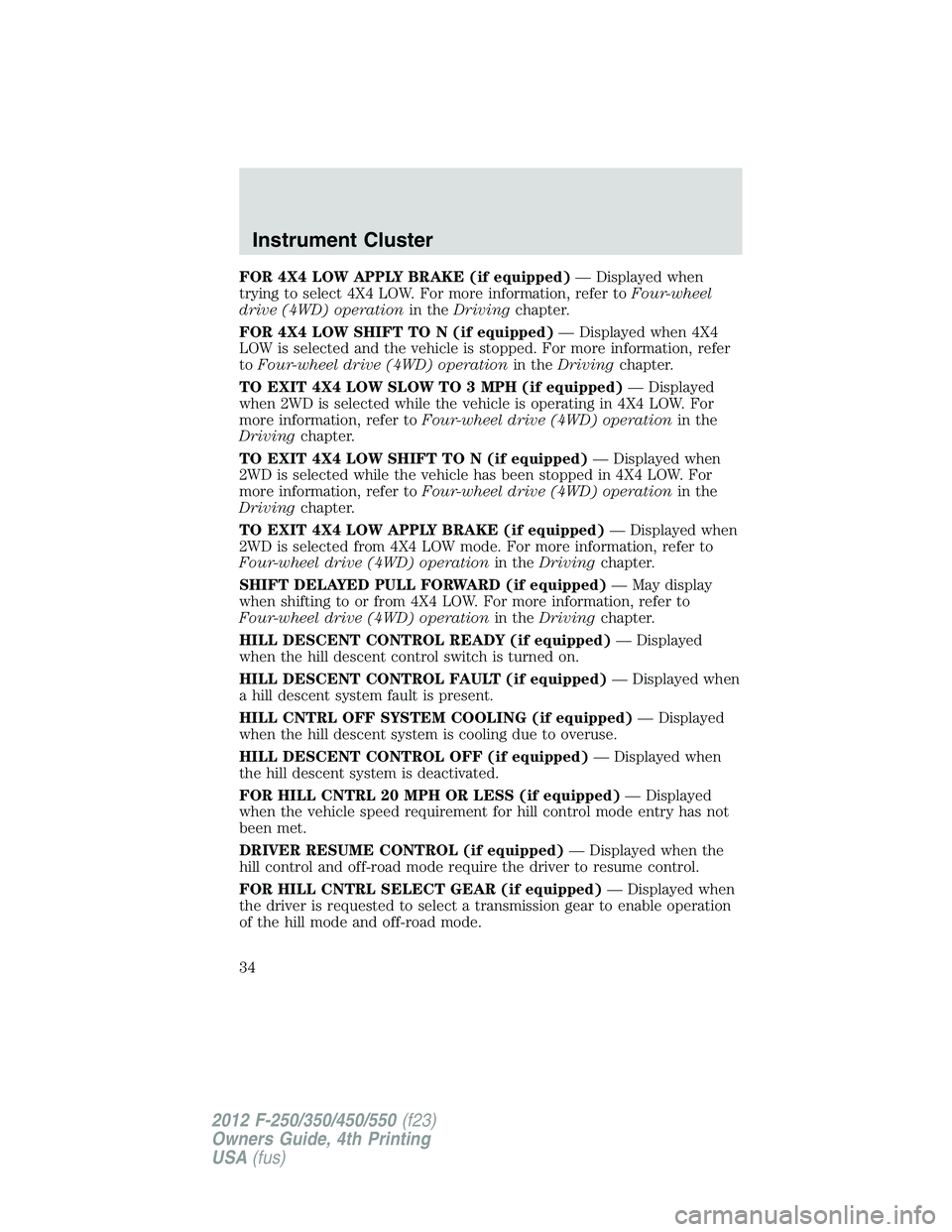
FOR 4X4 LOW APPLY BRAKE (if equipped) — Displayed when
trying to select 4X4 LOW. For more information, refer to Four-wheel
drive (4WD) operation in the Driving chapter.
FOR 4X4 LOW SHIFT TO N (if equipped) — Displayed when 4X4
LOW is selected and the vehicle is stopped. For more information, refer
to Four-wheel drive (4WD) operation in the Driving chapter.
TO EXIT 4X4 LOW SLOW TO 3 MPH (if equipped) — Displayed
when 2WD is selected while the vehicle is operating in 4X4 LOW. For
more information, refer to Four-wheel drive (4WD) operation in the
Driving chapter.
TO EXIT 4X4 LOW SHIFT TO N (if equipped) — Displayed when
2WD is selected while the vehicle has been stopped in 4X4 LOW. For
more information, refer to Four-wheel drive (4WD) operation in the
Driving chapter.
TO EXIT 4X4 LOW APPLY BRAKE (if equipped) — Displayed when
2WD is selected from 4X4 LOW mode. For more information, refer to
Four-wheel drive (4WD) operation in the Driving chapter.
SHIFT DELAYED PULL FORWARD (if equipped) — May display
when shifting to or from 4X4 LOW. For more information, refer to
Four-wheel drive (4WD) operation in the Driving chapter.
HILL DESCENT CONTROL READY (if equipped) — Displayed
when the hill descent control switch is turned on.
HILL DESCENT CONTROL FAULT (if equipped) — Displayed when
a hill descent system fault is present.
HILL CNTRL OFF SYSTEM COOLING (if equipped) — Displayed
when the hill descent system is cooling due to overuse.
HILL DESCENT CONTROL OFF (if equipped) — Displayed when
the hill descent system is deactivated.
FOR HILL CNTRL 20 MPH OR LESS (if equipped) — Displayed
when the vehicle speed requirement for hill control mode entry has not
been met.
DRIVER RESUME CONTROL (if equipped) — Displayed when the
hill control and off-road mode require the driver to resume control.
FOR HILL CNTRL SELECT GEAR (if equipped) — Displayed when
the driver is requested to select a transmission gear to enable operation
of the hill mode and off-road mode.Instrument Cluster
34
2012 F-250/350/450/550 (f23)
Owners Guide, 4th Printing
USA (fus)
Page 56 of 448
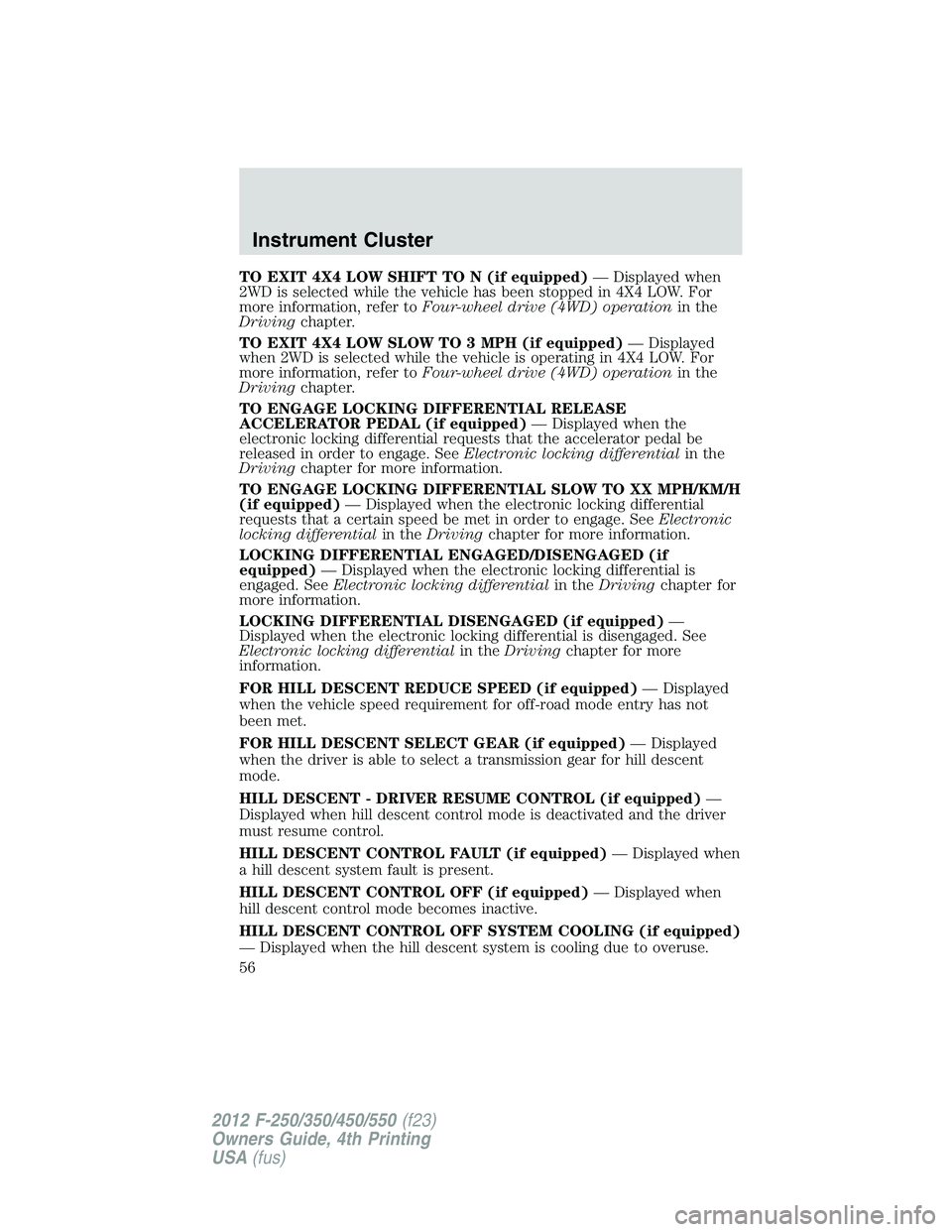
TO EXIT 4X4 LOW SHIFT TO N (if equipped) — Displayed when
2WD is selected while the vehicle has been stopped in 4X4 LOW. For
more information, refer to Four-wheel drive (4WD) operation in the
Driving chapter.
TO EXIT 4X4 LOW SLOW TO 3 MPH (if equipped) — Displayed
when 2WD is selected while the vehicle is operating in 4X4 LOW. For
more information, refer to Four-wheel drive (4WD) operation in the
Driving chapter.
TO ENGAGE LOCKING DIFFERENTIAL RELEASE
ACCELERATOR PEDAL (if equipped) — Displayed when the
electronic locking differential requests that the accelerator pedal be
released in order to engage. See Electronic locking differential in the
Driving chapter for more information.
TO ENGAGE LOCKING DIFFERENTIAL SLOW TO XX MPH/KM/H
(if equipped) — Displayed when the electronic locking differential
requests that a certain speed be met in order to engage. See Electronic
locking differential in the Driving chapter for more information.
LOCKING DIFFERENTIAL ENGAGED/DISENGAGED (if
equipped) — Displayed when the electronic locking differential is
engaged. See Electronic locking differential in the Driving chapter for
more information.
LOCKING DIFFERENTIAL DISENGAGED (if equipped) —
Displayed when the electronic locking differential is disengaged. See
Electronic locking differential in the Driving chapter for more
information.
FOR HILL DESCENT REDUCE SPEED (if equipped) — Displayed
when the vehicle speed requirement for off-road mode entry has not
been met.
FOR HILL DESCENT SELECT GEAR (if equipped) — Displayed
when the driver is able to select a transmission gear for hill descent
mode.
HILL DESCENT - DRIVER RESUME CONTROL (if equipped) —
Displayed when hill descent control mode is deactivated and the driver
must resume control.
HILL DESCENT CONTROL FAULT (if equipped) — Displayed when
a hill descent system fault is present.
HILL DESCENT CONTROL OFF (if equipped) — Displayed when
hill descent control mode becomes inactive.
HILL DESCENT CONTROL OFF SYSTEM COOLING (if equipped)
— Displayed when the hill descent system is cooling due to overuse.Instrument Cluster
56
2012 F-250/350/450/550 (f23)
Owners Guide, 4th Printing
USA (fus)
Page 78 of 448
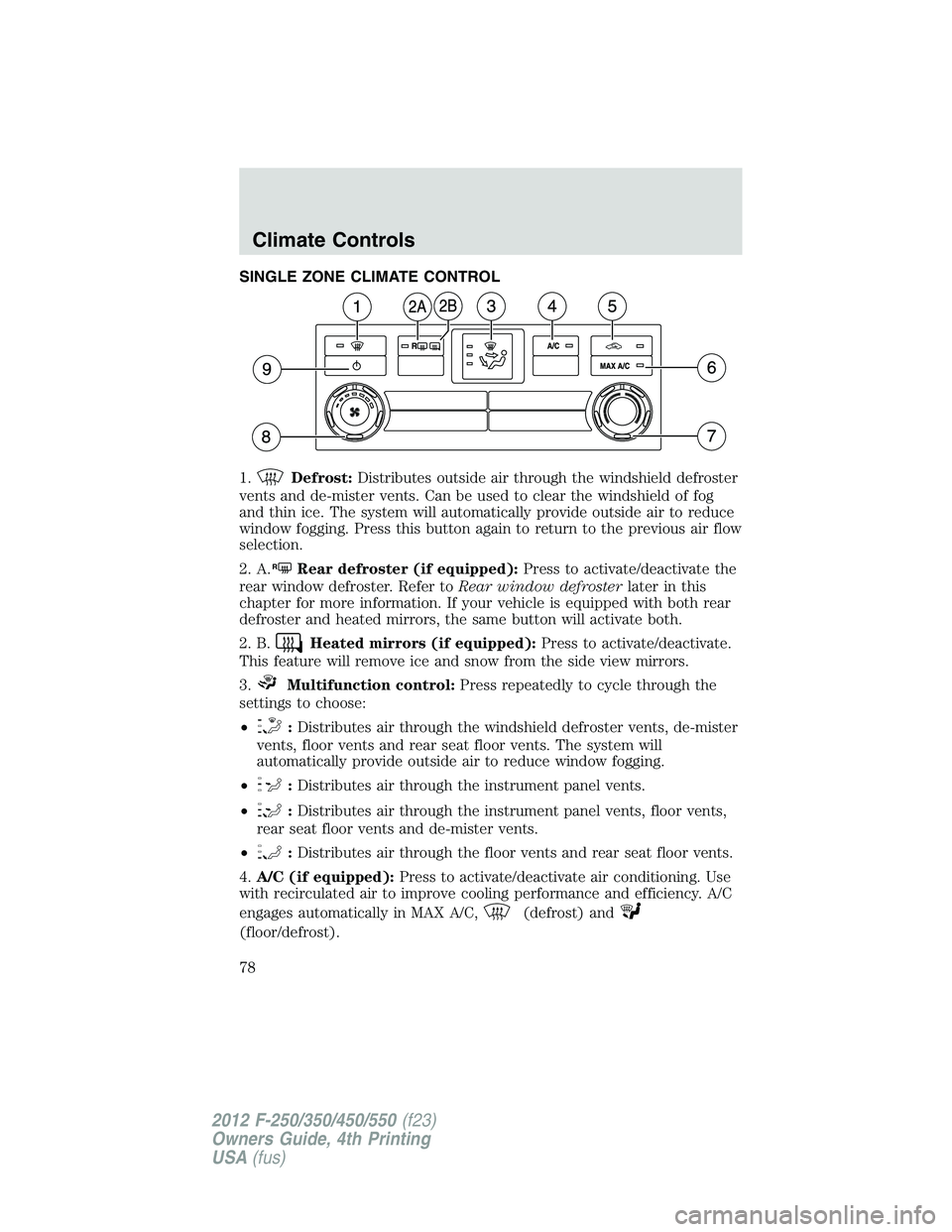
SINGLE ZONE CLIMATE CONTROL
1. Defrost: Distributes outside air through the windshield defroster
vents and de-mister vents. Can be used to clear the windshield of fog
and thin ice. The system will automatically provide outside air to reduce
window fogging. Press this button again to return to the previous air flow
selection.
2. A. R
Rear defroster (if equipped): Press to activate/deactivate the
rear window defroster. Refer to Rear window defroster later in this
chapter for more information. If your vehicle is equipped with both rear
defroster and heated mirrors, the same button will activate both.
2. B. Heated mirrors (if equipped): Press to activate/deactivate.
This feature will remove ice and snow from the side view mirrors.
3. Multifunction control: Press repeatedly to cycle through the
settings to choose:
• : Distributes air through the windshield defroster vents, de-mister
vents, floor vents and rear seat floor vents. The system will
automatically provide outside air to reduce window fogging.
• : Distributes air through the instrument panel vents.
• : Distributes air through the instrument panel vents, floor vents,
rear seat floor vents and de-mister vents.
• : Distributes air through the floor vents and rear seat floor vents.
4. A/C (if equipped): Press to activate/deactivate air conditioning. Use
with recirculated air to improve cooling performance and efficiency. A/C
engages automatically in MAX A/C, (defrost) and
(floor/defrost).Climate Controls
78
2012 F-250/350/450/550 (f23)
Owners Guide, 4th Printing
USA (fus)
Page 79 of 448
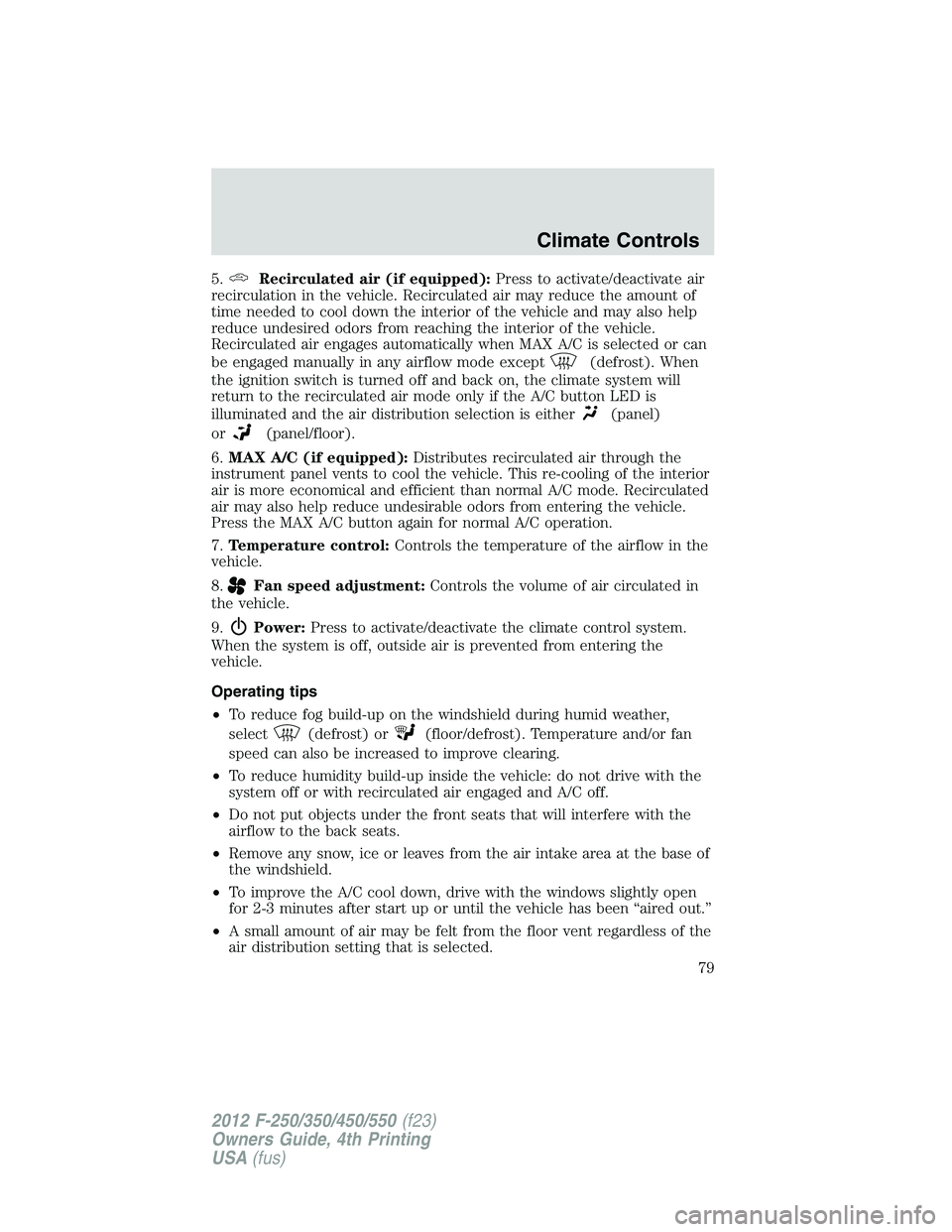
5. Recirculated air (if equipped): Press to activate/deactivate air
recirculation in the vehicle. Recirculated air may reduce the amount of
time needed to cool down the interior of the vehicle and may also help
reduce undesired odors from reaching the interior of the vehicle.
Recirculated air engages automatically when MAX A/C is selected or can
be engaged manually in any airflow mode except (defrost). When
the ignition switch is turned off and back on, the climate system will
return to the recirculated air mode only if the A/C button LED is
illuminated and the air distribution selection is either (panel)
or (panel/floor).
6. MAX A/C (if equipped): Distributes recirculated air through the
instrument panel vents to cool the vehicle. This re-cooling of the interior
air is more economical and efficient than normal A/C mode. Recirculated
air may also help reduce undesirable odors from entering the vehicle.
Press the MAX A/C button again for normal A/C operation.
7. Temperature control: Controls the temperature of the airflow in the
vehicle.
8. Fan speed adjustment: Controls the volume of air circulated in
the vehicle.
9. Power: Press to activate/deactivate the climate control system.
When the system is off, outside air is prevented from entering the
vehicle.
Operating tips
• To reduce fog build-up on the windshield during humid weather,
select (defrost) or (floor/defrost). Temperature and/or fan
speed can also be increased to improve clearing.
• To reduce humidity build-up inside the vehicle: do not drive with the
system off or with recirculated air engaged and A/C off.
• Do not put objects under the front seats that will interfere with the
airflow to the back seats.
• Remove any snow, ice or leaves from the air intake area at the base of
the windshield.
• To improve the A/C cool down, drive with the windows slightly open
for 2-3 minutes after start up or until the vehicle has been “aired out.”
• A small amount of air may be felt from the floor vent regardless of the
air distribution setting that is selected. Climate Controls
79
2012 F-250/350/450/550 (f23)
Owners Guide, 4th Printing
USA (fus)
Page 80 of 448

If you are driving during extreme high ambient temperatures and idling
for extended periods of time in gear, it is recommended to run the A/C
in the MAX A/C position, adjust the blower fan speed to the lowest
setting and put the vehicle’s transmission into the P (Park) position to
continue to receive cool air from your A/C system.
For maximum cooling performance (MAX A/C):
1. Select MAX A/C.
2. Move the temperature control to the coolest setting.
3. Set the fan speed to the highest setting and then adjust as necessary
to maintain comfort.
• A/C and
(recirculated air) will be automatically selected.
• Airflow will automatically be directed out of the panel vents.
To aid in side window defogging/demisting in cold weather:
1. Select
(panel/floor).
2. Select A/C.
3. Adjust the temperature control to maintain comfort.
4. Set the fan speed to the highest setting.
5. Direct the outer instrument panel vents towards the side windows.
To increase airflow to the outer instrument panel vents, close the vents
located in the middle of the instrument panel.Climate Controls
80
2012 F-250/350/450/550 (f23)
Owners Guide, 4th Printing
USA (fus)
Page 82 of 448
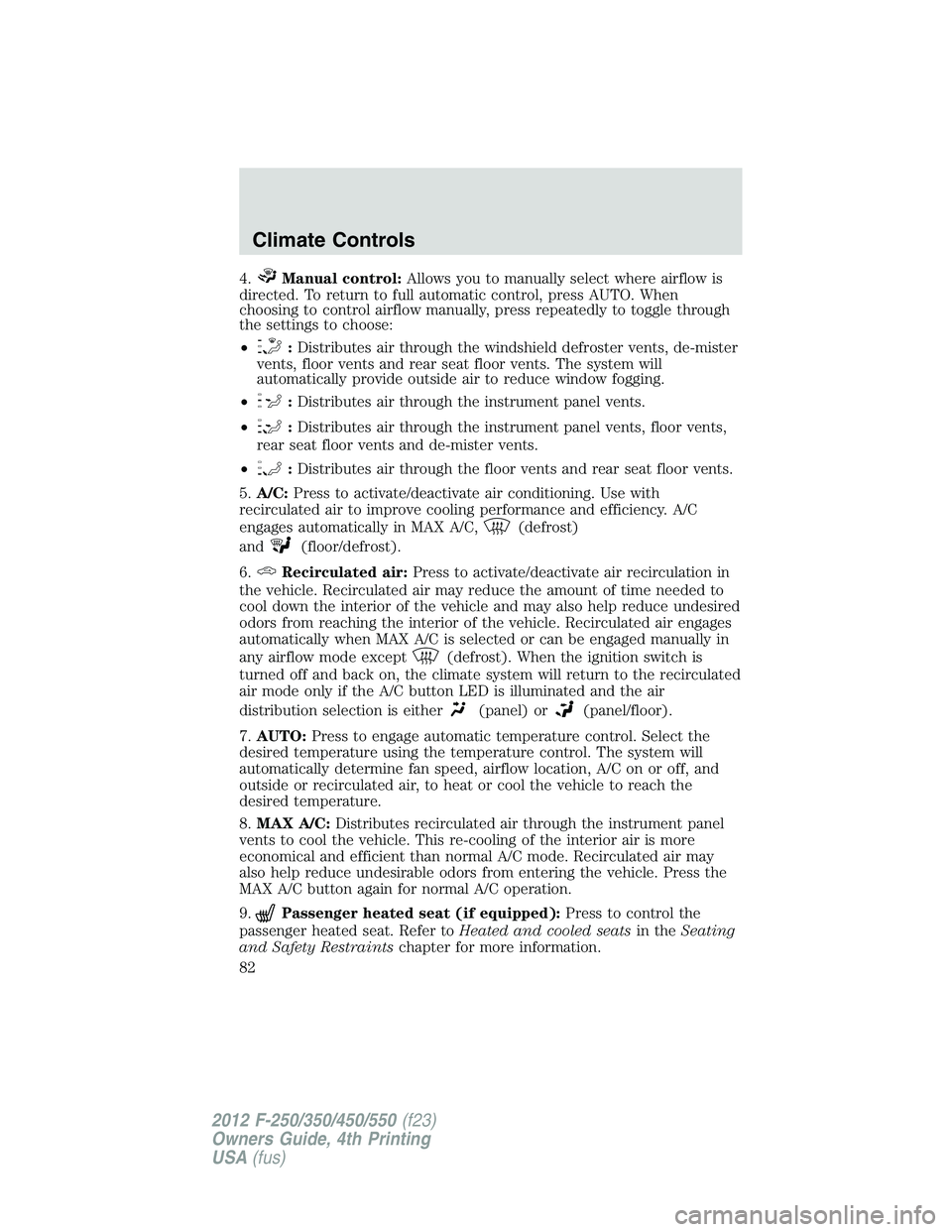
4. Manual control: Allows you to manually select where airflow is
directed. To return to full automatic control, press AUTO. When
choosing to control airflow manually, press repeatedly to toggle through
the settings to choose:
• : Distributes air through the windshield defroster vents, de-mister
vents, floor vents and rear seat floor vents. The system will
automatically provide outside air to reduce window fogging.
• : Distributes air through the instrument panel vents.
• : Distributes air through the instrument panel vents, floor vents,
rear seat floor vents and de-mister vents.
• : Distributes air through the floor vents and rear seat floor vents.
5. A/C: Press to activate/deactivate air conditioning. Use with
recirculated air to improve cooling performance and efficiency. A/C
engages automatically in MAX A/C, (defrost)
and (floor/defrost).
6. Recirculated air: Press to activate/deactivate air recirculation in
the vehicle. Recirculated air may reduce the amount of time needed to
cool down the interior of the vehicle and may also help reduce undesired
odors from reaching the interior of the vehicle. Recirculated air engages
automatically when MAX A/C is selected or can be engaged manually in
any airflow mode except (defrost). When the ignition switch is
turned off and back on, the climate system will return to the recirculated
air mode only if the A/C button LED is illuminated and the air
distribution selection is either (panel) or (panel/floor).
7. AUTO: Press to engage automatic temperature control. Select the
desired temperature using the temperature control. The system will
automatically determine fan speed, airflow location, A/C on or off, and
outside or recirculated air, to heat or cool the vehicle to reach the
desired temperature.
8. MAX A/C: Distributes recirculated air through the instrument panel
vents to cool the vehicle. This re-cooling of the interior air is more
economical and efficient than normal A/C mode. Recirculated air may
also help reduce undesirable odors from entering the vehicle. Press the
MAX A/C button again for normal A/C operation.
9. Passenger heated seat (if equipped): Press to control the
passenger heated seat. Refer to Heated and cooled seats in the Seating
and Safety Restraints chapter for more information.Climate Controls
82
2012 F-250/350/450/550 (f23)
Owners Guide, 4th Printing
USA (fus)
Page 84 of 448

• Remove any snow, ice or leaves from the air intake area at the base of
the windshield.
• To improve the A/C cool down, drive with the windows slightly open
for 2-3 minutes after start up or until the vehicle has been “aired out”.
• A small amount of air may be felt from the floor vent regardless of the
air distribution setting that is selected.
During extreme high ambient temperatures when idling stationary for
extended periods of time in gear, it is recommended to run the A/C in
the max A/C position, reduce blower fan speed from the highest setting
and put the vehicle’s transmission into the P (Park) gear position
(automatic transmission only) to continue to receive cool air from your
A/C system.
For maximum cooling performance:
• Automatic operation:
1. Press AUTO for full automatic operation.
2. Do not override A/C or (recirculated air).
3. Set the temperature to 60°F (16°C).
• Manual operation:
1. Select MAX A/C. The system will automatically default to single zone
operation and set the temperature to 60°F (16°C).
• A/C and (recirculated air) will be selected.
• Airflow will be directed out of the panel vents.
2. Fan speed will be automatically increased to the highest setting but
can be adjusted as desired.
To aid in side window defogging/demisting in cold weather:
1. Select (panel/floor).
2. Select A/C.
3. Adjust the temperature control to maintain comfort.
4. Set the fan speed to the highest setting.
5. Direct the outer instrument panel vents towards the side windows.
To increase airflow to the outer instrument panel vents, close the vents
located in the middle of the instrument panel.Climate Controls
84
2012 F-250/350/450/550 (f23)
Owners Guide, 4th Printing
USA (fus)
Page 161 of 448

Heated and cooled seats (if equipped)
The controls for the climate controlled seats are located on the climate
control system.
Heated Seats
WARNING: Persons who are unable to feel pain to the skin
because of advanced age, chronic illness, diabetes, spinal cord
injury, medication, alcohol use, exhaustion, or other physical
conditions, must exercise care when using the seat heater. The seat
heater may cause burns even at low temperatures, especially if used
for long periods of time. Do not place anything on the seat that
insulates against heat, such as a blanket or cushion, because this may
cause the seat heater to overheat. Do not puncture the seat with pins,
needles, or other pointed objects because this may damage the heating
element which may cause the seat heater to overheat. An overheated
seat may cause serious personal injury.
• Do not place heavy objects on the seat.
• Do not operate the seat heater if water or any other liquid is spilled
on the seat. Allow the seat to dry thoroughly.
The heated seats will only function when the engine is running.
To operate the heated seats:
Press the heated seat button/symbol
to cycle through the various heat
settings and off. Warmer settings are
indicated by more indicator lights.
Cooled Seats
The cooled seats will only function when the engine is running.
To operate the cooled seats:
Press the cooled seat button/symbol
to cycle through the various cooling
settings and off. Cooler settings are
indicated by more indicator lights.
If the engine falls below 350 rpm while the cooled seats are on, the
feature will turn itself off and will need to be reactivated.
A/CSeating and Safety Restraints
161
2012 F-250/350/450/550 (f23)
Owners Guide, 4th Printing
USA (fus)
Page 260 of 448

• The TBC interacts with the brake system of the vehicle, including
ABS, in order to reduce the likelihood of trailer wheel lock-up;
therefore, if these systems are not functioning properly, the TBC may
not function at full performance.
• Your vehicle’s brake system and the trailer brake system work
independently of each other; changing the GAIN setting on the TBC
does not affect the operation of your vehicle’s brakes whether a trailer
is attached or not.
• When the vehicle is turned off, the TBC output is disabled and the
display is shut down; turning the ignition from off to on awakens the
TBC module.
• The TBC is only a factory- or dealer-installed item; Ford is not
responsible for warranty or performance of the TBC due to misuse or
customer installation.
• Do not attempt removal of the TBC without consulting the
Workshop Manual; damage to the unit may result.
Trailer Lamps
Trailer lamps are required on most towed vehicles. Make sure all running
lights, brake lights, turn signals and hazard lights are working. Contact
your authorized dealer or trailer rental agency for proper instructions
and equipment for hooking-up trailer lamps.
Driving while you tow
When towing a trailer:
• Consult your local motor vehicle laws for towing a trailer.
• Do not drive faster than 70 mph (113 km/h) during the first 500 miles
(800 km) of trailer towing and don’t make full-throttle starts.
• Turn off the speed control. The speed control may shut off
automatically when you are towing on long, steep grades.
• Activate the tow/haul feature to eliminate excessive transmission
shifting and assist in transmission cooling. For additional information,
refer to Automatic transmission operation in the Driving chapter.
• Allow more distance for stopping with a trailer attached; anticipate
stops and brake gradually.Tires, Wheels and Loading
260
2012 F-250/350/450/550 (f23)
Owners Guide, 4th Printing
USA (fus)
Page 281 of 448
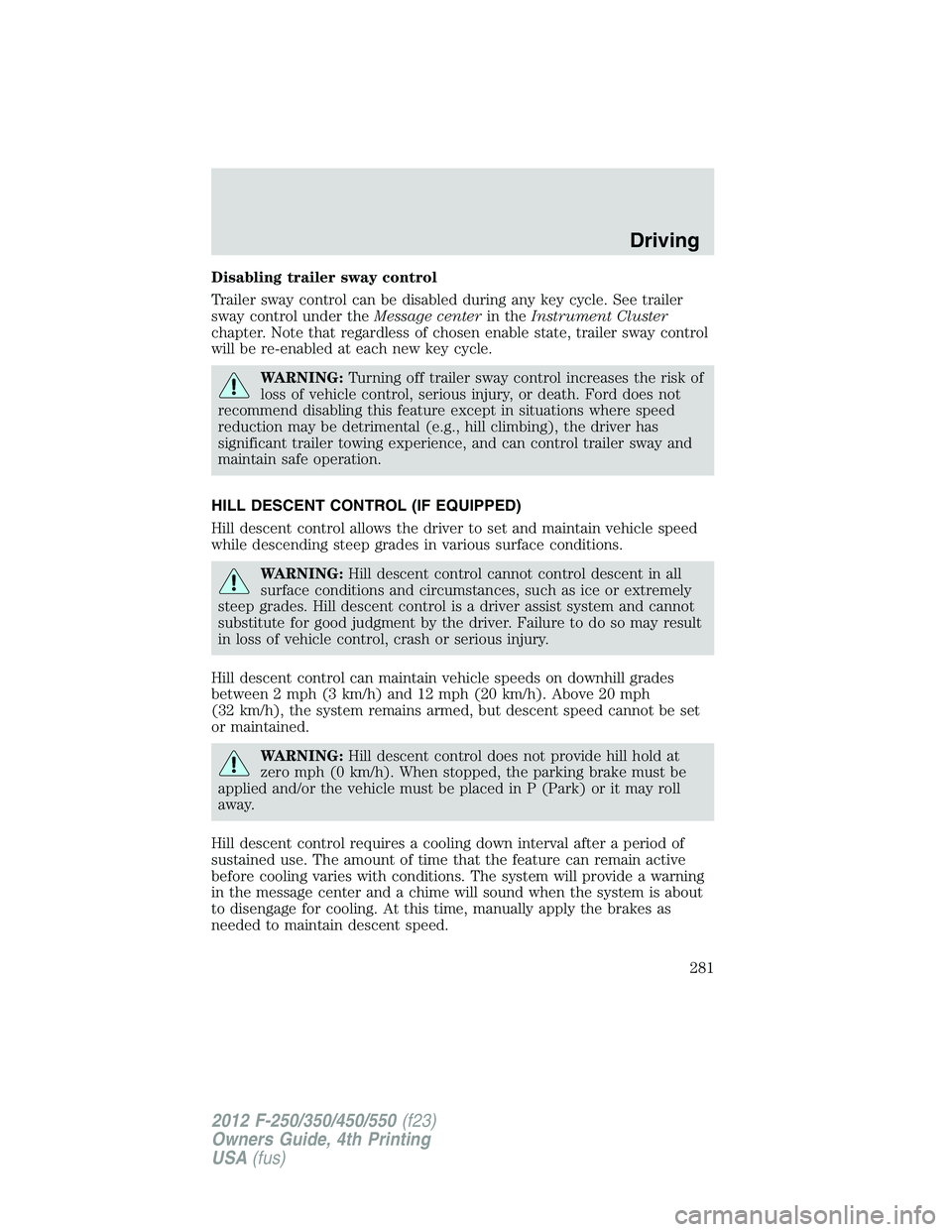
Disabling trailer sway control
Trailer sway control can be disabled during any key cycle. See trailer
sway control under the Message center in the Instrument Cluster
chapter. Note that regardless of chosen enable state, trailer sway control
will be re-enabled at each new key cycle.
WARNING: Turning off trailer sway control increases the risk of
loss of vehicle control, serious injury, or death. Ford does not
recommend disabling this feature except in situations where speed
reduction may be detrimental (e.g., hill climbing), the driver has
significant trailer towing experience, and can control trailer sway and
maintain safe operation.
HILL DESCENT CONTROL (IF EQUIPPED)
Hill descent control allows the driver to set and maintain vehicle speed
while descending steep grades in various surface conditions.
WARNING: Hill descent control cannot control descent in all
surface conditions and circumstances, such as ice or extremely
steep grades. Hill descent control is a driver assist system and cannot
substitute for good judgment by the driver. Failure to do so may result
in loss of vehicle control, crash or serious injury.
Hill descent control can maintain vehicle speeds on downhill grades
between 2 mph (3 km/h) and 12 mph (20 km/h). Above 20 mph
(32 km/h), the system remains armed, but descent speed cannot be set
or maintained.
WARNING: Hill descent control does not provide hill hold at
zero mph (0 km/h). When stopped, the parking brake must be
applied and/or the vehicle must be placed in P (Park) or it may roll
away.
Hill descent control requires a cooling down interval after a period of
sustained use. The amount of time that the feature can remain active
before cooling varies with conditions. The system will provide a warning
in the message center and a chime will sound when the system is about
to disengage for cooling. At this time, manually apply the brakes as
needed to maintain descent speed. Driving
281
2012 F-250/350/450/550 (f23)
Owners Guide, 4th Printing
USA (fus)